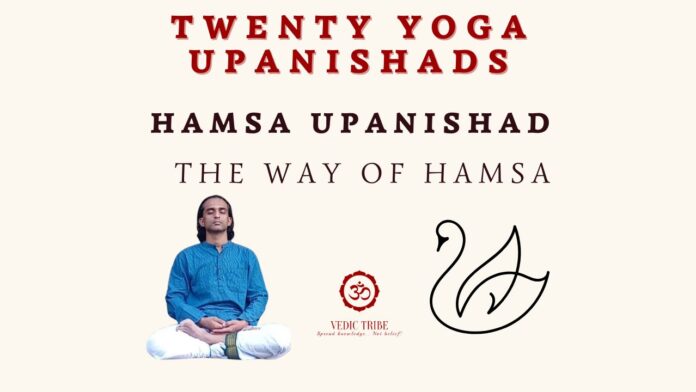What is Hamsa Upanishad?
In the previous article, we outlined twenty Yoga Upanishads and explained how they encapsulate the ancient Vedic wisdom of Yogic practices. In this article, we will discuss – Hamsa Upanishad.
Hamsa Upanishad records one of the ancient meditation practices – “Hamsa Vidya”. The Upanishad explains “Ajapa Hamsa Mantra” (observation of breath) for such meditative practices.
This Hamsa Vidya is also explained in different methods in other Yoga Upanishads like Dhyanabindu, Brahmavidya, Pashupata Brahma and Mahavakya.
The Symbolism of the Hamsa
Atma and Paramatma: The Hamsa, a graceful bird and is used as an allegory for the human spirit. It is fantasised to have the ability to disperse milk from water, symbolizing the discriminating power of an unruffled mind. In the context of yoga, the Hamsa represents the individual soul (Atman) on its journey towards union with the Supreme Being (Brahman).
Charm and glamour: Ancient Rishis were captivated by the ability of Hamsa crossing Himalayan hights and were enchanted by their charm & glamour. High flight of Hamsa were used as symbol for the ability of the individual soul to achieve spiritual hights. The pure conscious nature of the individual soul was represented by the charm & glamour of Hamsa.
Vishnu Sahasra Nama: In Vishnu Sahasra Nama, one of the names of almighty is “Hamsa” indicating divine’s ability to liberate individual souls and to move the cosmos (shloka 21)
The Hamsa Vidya: A Meditation Technique
Ajapa Hamsa Mantra: The Upanishad provides an ancient meditation technique of observing breath alone. The sound observed during the breathing is called “ajapa- hamsa – mantra”. During inhalation “ham” sound is observed and during exhalation “sa” is observed. It is observed with two perspectives: Hamsa and So-ham, both being the name of the almighty.
Nada Brahma: With prolonged practice, the Upanishad says, one will realize the “nada-brahma” i.e., manifestation of Brahman in the sounds of the cosmos as well as the microcosm. The Upanishad also says that such realization occurs in Anahata chakra (at the centre of the chest).
Rishi: The individual soul itself is considered the Rishi for Hamsa Mantra because the meditation involves – us directly observing our breath and recognizing the subtle sound of “Hamsa” in our breath.
Chandas: Gayatri Chandas (meter) is called “Veda Mata” and is considered the most auspicious of all Vedic meters. The Upanishad says that in our very breath, this Chandas resides in subtle form; hence it is “Avyakta Gayatri Chandas” is the Chandas of Hamsa Mantra.
Deity: The supreme Lord – Paramahamsa Or Hamsatman – shall be meditated upon and hence it is the deity of Hamsa Mantra.
The Influence of the Hamsa Upanishad
Advaita: It may be noted that this Upanishad being a recent one, was compiled after the promulgation of Advaita Vedanta by Sri Shankaracharya and many concepts of Advaita is found here. In Advaita tradition, “Soham” is interpreted as – I am what that is (Parabrahman). Similar interpretation is made in Hamsa Upanishad indicating meditation upon individual consciousness equated with cosmic consciousness.
Contemporary Hamsa Meditation: Today many different meditation techniques are taught in the name of “Hamsa Meditation”. Most of these teachings are devoid of the spiritual insights of Hamsa Upanishad. One should first understand the underlying spiritual essence of Upanishads as a whole, before practicing such modern methods.
Key takeaway:
– Study Hamsa Upanishad and understand its meaning from a scholar and adopt teachings of this Upanishad in your meditative practices.
– If you encounter modern meditation technique claiming to be Hamsa Vidya or Hamsa Meditation, question its authority and time tested tradition.
In the next article, we will discuss– “Amritabindu Upanishad”.
Madhwesh K
Vedic Tribe

